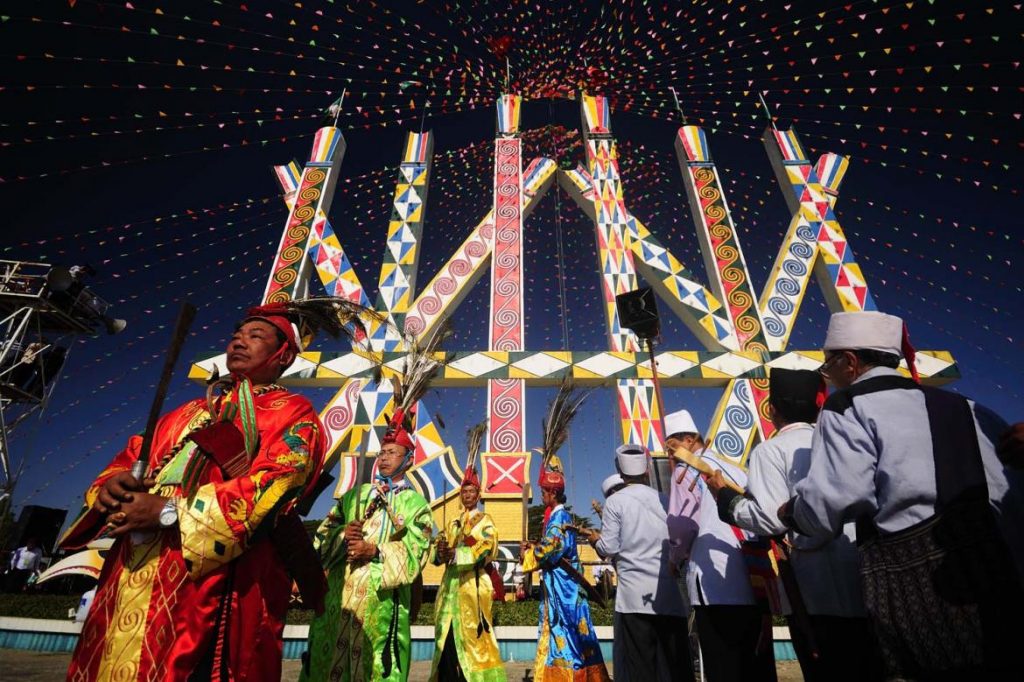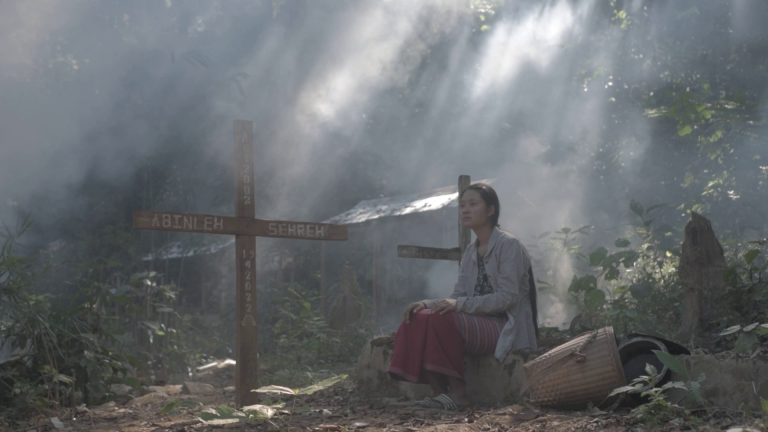A dispute over how to name the Kachin State Day Manau Festival in Myitkyina has revealed fissures in Kachin’s multi-ethnic society.
By EMILY FISHBEIN | FRONTIER
AS A CHILD, Khang would eagerly look forward to Kachin State Day on January 10 and the accompanying manau dancing in the state capital, Myitkyina. This year, that feeling all but disappeared, said Khang, now aged 26.
“I feel like Kachin State Day is just for show. The celebration doesn’t come from the bottom of our heart,” said Khang, who is from the Rawang ethnic group in Kachin. “We Kachin are lacking harmony… It’s like there is something between us, that we are not all the same.”
The festival planned for January 5-12 this year was to be the first Kachin State Day celebration initiated by Kachin society, rather than the government, since conflict resumed between the Kachin Independence Army and the Tatmadaw in 2011. The event, commemorated with traditional dancing around the six pillars that stand in Myitkyina’s Kachin National Manau Park, is known popularly as the Manau Festival.
Discord leading up to this year’s Kachin State Day event, however – including a cancellation and last-minute resumption – dampened the spirits of many Kachin.
Support more independent journalism like this. Sign up to be a Frontier member.
The dispute, which stemmed from disagreement over what to call Kachin State Day in Jinghpaw, the Kachin lingua franca, touched a nerve within Kachin’s diverse society and prompted a broader debate about Kachin identity and who gets to define it.
Anthropologist of Kachin society Mr Laur Kiik describes Kachin as a multi-ethnic nation, integrating people from six or more ethnic groups to widely varying degrees. Debate over the names and boundaries of a Kachin identity, he said, has existed for decades; and Kachin State Day manau festivals have previously brought these debates out into the open.
Though the Myanmar government recognises 12 Kachin “sub-groups”, the Kachin National Association of Tradition and Culture, or Wunpawng Myusha Htunghking Hpung Ginjaw (known by the clipped acronym WHG), represents six linguistically distinct groups – Jinghpaw, Lachid, Lhaovo, Lisu, Rawang and Zaiwa.
Kachin State Day commemorates the day in 1948 when Kachin State was formed, six days after Burma became independent on January 4, 1948. During the Panglong Conference in February 1947, General Aung San had pledged the Kachin and other ethnic leaders “full autonomy in internal administration”.
Autonomy was never accorded to the Kachin, sparking an armed revolt led by the Kachin Independence Organisation that began in 1961 and has continued to the present day, except for a ceasefire between 1994 and 2011. Despite political grievances, however, Kachin State Day calls upon the state’s different communities to join and dance in a spirit of unity. Yet cracks in this unity seemed to widen in the weeks leading up to the festival.
Picking up on a debate from the run-up to last year’s festival, some advocated for the Jinghpaw name of this year’s Kachin State Day to be changed from Jinghpaw Mungdaw Nhtoi, which it has been called from the beginning, to Kachin Mungdaw Nhtoi in order to be more inclusive of all Kachin. Meanwhile, others held strongly to Jinghpaw Mungdaw Nhtoi, arguing that it already represents all Kachin or that it should only be changed via a referendum.
Starting with the appearance of a vinyl banner, the issue escalated to the point of its cancellation. Although it ultimately resumed at the behest of the state government, many were disillusioned about the event.
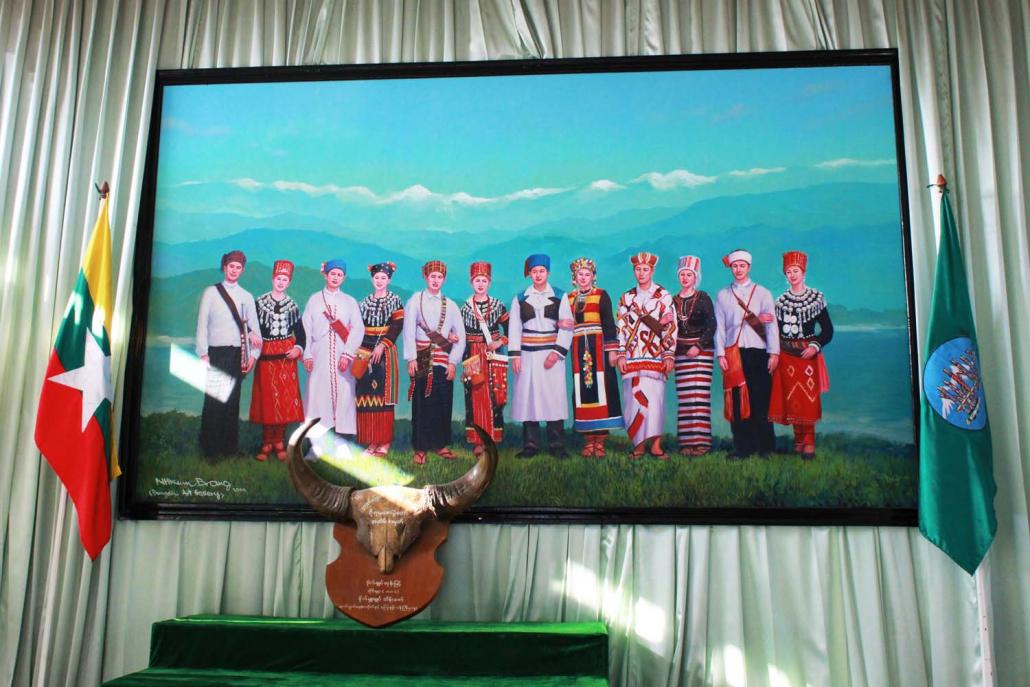
A painting representing six Kachin ethnic groups in their traditional dress hangs in the Myitkyina office of the Kachin National Association of Tradition and Culture. (Emily Fishbein | Frontier)
A ‘very meaningful’ name
This year, Kachin State Day festivities were initiated by WHG and organised and funded jointly by the state government and WHG. The festival’s budget was estimated at K450 million, including a K250 million contribution from the state government. The remaining funds were sought by WHG through private donations and vendor fees, 72nd Kachin State Day Organising Committee chair Kinraw Tang Gun told Frontier.
WHG is comprised of 20 representatives from each of Kachin’s six culture and literature associations, among which four people from each association form its central committee, chaired through a three-year rotation among the six associations. Its current chair, U Hton Pu Dagon, is Rawang.
This year’s festival was to include two days of manau dancing and a further six days of sports and talent competitions, with hundreds of vendors catering to festival-goers. Following the cancellation, the resumed festival was shortened to one day; vendors were given the choice of receiving their site rental fees back, or having the money put towards an event planned tentatively for Union Day, one vendor told Frontier.
Kachin State Day festivals were held in 2015 and 2019, initiated by the government, but were controversial because many Kachin believed that manau dancing should not occur during a time of conflict and when an estimated 100,000 people continue to languish in camps for the internally displaced.
The attendance of State Counsellor Aung San Suu Kyi at the shortened event, announced just days before, served as a reminder to some of how little had changed. Youth leader and peace and human rights activist Jaw Tu Hkawng, part of the Kachin diaspora in Malaysia, told Frontier, “As a Kachin youth, I feel insulted to celebrate Kachin State Day [in] the current situation of ongoing civil war, with 100,000 Kachin displaced.”
“I feel that the celebration [in Myitkyina] was held to deliver the government’s hidden agenda, for political gain in advance of the 2020 elections,” he said. “Aung San Suu Kyi gives sweet speeches and promises of equal rights to Kachin people, but these promises have not been fulfilled.”
At the same time, a more delicate controversy, carried over from last year, cast a shadow over this year’s event. In advance of last year’s Kachin State Day, a promotional vinyl banner that called it Kachin Mungdaw Nhtoi in Jinghpaw was burned, following which the event name was changed back to Jinghpaw Mungdaw Nhtoi.
The sparks were reignited leading up to this year’s event when, in early December, the event’s organisers put up a vinyl banner at the entrance to the Kachin National Manau Park, this time calling Kachin State Day Mungdaw Nhtoi – again, without the word Jinghpaw.
On December 22, the Kachin Independence Organisation’s central committee released a letter addressed to the Kachin National Consultative Assembly, or Wunpawng Amyusha Mungbawng Rapdaw (WMR) and the Peace-talk Creation Group, a group of Kachin businessmen who practice conflict mediation in Kachin. The letter stated that Jinghpaw Mungdaw Nhtoi had been used consistently since January 10, 1948 and should therefore remain; that there should be no dispute among Kachin’s ethnic groups, and that they should comply with the decisions of the Kachin State Government regarding the Kachin State Day event. The KIO also said it had delegated WMR and the PCG to address the issue with the leaders of the dissenting culture and literature associations.
WMR chair La Aung told Frontier, “The name Jinghpaw Mungdaw is very meaningful, dating back to Kachin State’s formation under the Union of Burma. If all six Kachin tribes agree through a referendum to change the name, we can change it, but right now, we cannot change it, because of the name’s international legitimacy.” A referendum, he said, should include all Kachin throughout the world.
The day after the KIO’s letter, the Kachin State government entered the conversation, issuing a letter that said changing the name of Kachin State Day would require an assembly and a worldwide Kachin referendum. Because there was not time to convene either, only the Burmese name would be used for the upcoming event, the state government said.
On December 30, WHG released a letter saying the state government had withheld permission for the festival, citing a letter they had received three days before. WHG requested that a substitute festival involving Manau dancing be held in February, to coincide with Union Day on February 12. On the last day of the year, the banners at the entrance to Manau Park announcing the Kachin State Day event were taken down.
In a final turn of events, on January 6, the state government announced that the Kachin State Day festival would proceed after all, using only its Burmese name. The following morning, about 20 people demonstrated in front of Myitkyina’s Manau Park, calling for the dissolution of WHG and the resignation of its chair, as well as the use of the name Jinghpaw Mungdaw Nhtoi.
Following further mediation by the Peace-Talk Creation Group, on January 8, a banner with the title Jinghpaw Mungdaw Nhtoi appeared at the Manau Park gates. In response, the Lachid, Lhaovo, Lisu, Rawang and Zaiwa culture and literature associations issued statements opposing the use of “Jinghpaw” – reminiscent of letters they had issued just days before last year’s event – indicating that the controversy remains unresolved.
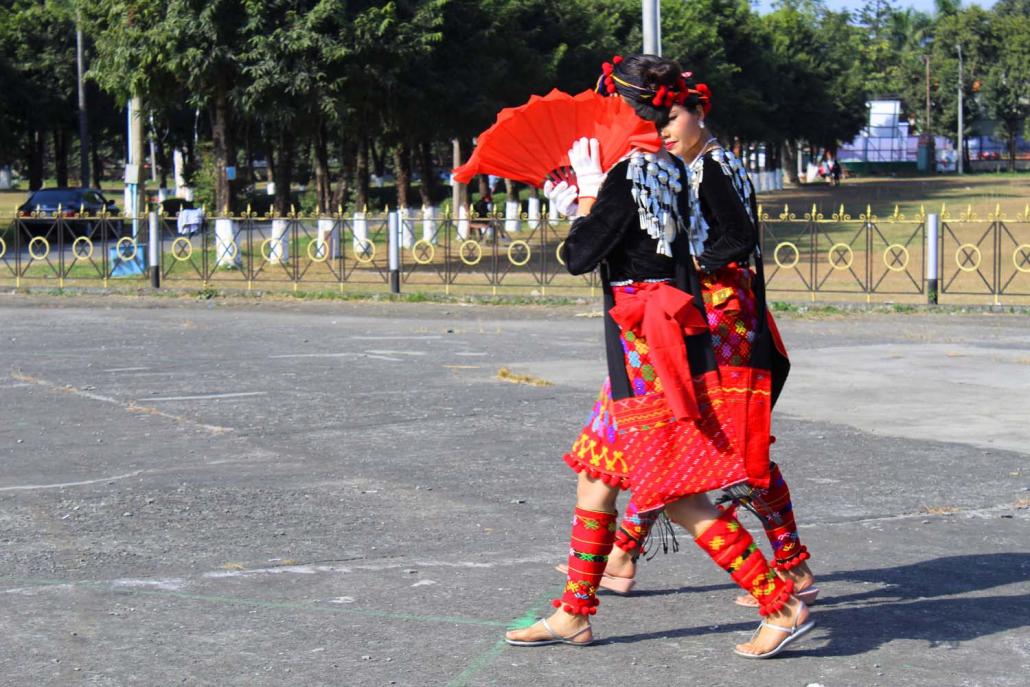
Kachin youth at a dance practice session in Kachin National Manau Park in preparation for Kachin State Day. (Emily Fishbein | Frontier)
Dancing birds
The tradition of dancing manau extends well beyond Kachin State Day in time and scope. Reverend Marip Bawk San, an archivist of Kachin traditions, said that manau dance is held to call upon lamu madai, or beings living in the sky, to descend to earth to learn about people’s needs. The dance, he said, is influenced by movement patterns from nature, including flocks of birds, schools of fish and butterflies.
Frontier encountered different accounts of the origins of manau dancing. Shichyang Zung Ting, a doctoral candidate of Kachin folklore at the North-Eastern Hill University in India, said the story starts with a man named Mading Yaw. He was a very lazy man, and villagers didn’t like him. One day, they trapped him in a basket, which they hung under a banyan tree by the riverside. While he was sitting in the basket, many hornbill birds came to eat the tree’s fruit, and he saw the birds dancing. Shichyang Zung Ting said the story offers one explanation for why the image of a hornbill’s head features in the manau dance.
Nhpan Ja Ra, 89, a prominent Kachin elder who served as a judge in Kachin from 1974 -79, recounted another legend. According to her account, a long time ago, the ancestors of the Kachin arrived at the source of the Mali Mai River. With them was a speaking buffalo who told the travellers, “Now, my time is ending. You can sacrifice me to the spirits, and then dance, and separate.” The nat saya [traditional storyteller] touched the buffalo and, without any blood being shed, the buffalo died and the people separated, village by village, filling the whole world.
Also varied are explanations of the manau pillars, an icon of Kachin culture that stand in cities and towns throughout Kachin as well as in Ruili, China, Arunachal Pradesh, India, and Banmai Samakki, Thailand. The pillars’ intricate, colourful patterns differ from place to place, as does the number of pillars. Six pillars – the most common representation and the number in Myitkyina’s Kachin National Manau Park – is interpreted by some as representing six Kachin groups; in China, there are sometimes four pillars, and in Putao, in far northern Kachin, there are five, which some interpret as representing five fingers, a symbol of strength. Manau pillars were originally made of bamboo and later of wood but are today commonly made from concrete.
Marip Bawk San said new reasons for dancing manau, and accompanying names, are constantly being created. One well-known variety is padang manau, which represents victory in war and was famously performed at Kutkai in Shan State in 1945 to celebrate the contribution of Kachin soldiers to driving the Japanese out of Burma. Kumran manau represents moving from one place to another; other types of manau include hting ram manau, for making amends; sut manau, for wealth, and ju manau, for health. Recent years have also seen church anniversary celebrations known as jubilee manau.
Shichyang Zung Ting sees the many stories and traditions of manau not as contradicting each other but rather as a compilation that reflects the rich variety of Kachin culture. “Every group has their own unique symbols, patterns and interpretations to contribute. Kachin’s shared culture [of] manau can bring unity,” he said.
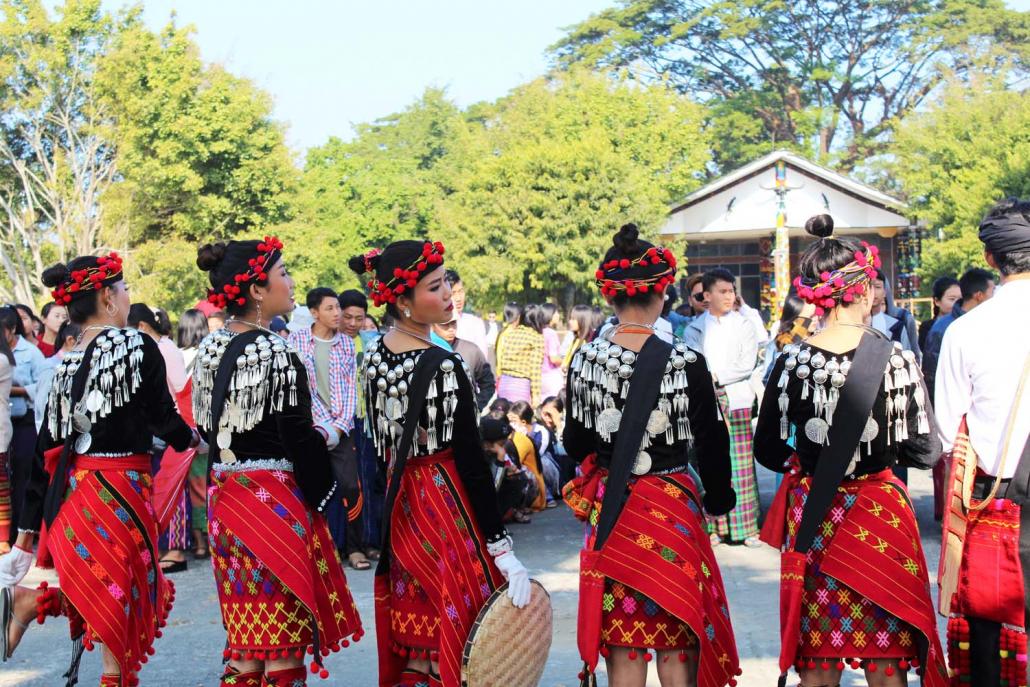
Kachin youth rehearse dances in the Kachin National Manau Park in December to prepare for Kachin State Day. (Emily Fishbein | Frontier)
‘In the past, nobody spoke’
The debate over the modern usage of the name for Kachin State Day in Jinghpaw exploded on Facebook in lead up to this year’s festival. Some suggested that the name was already inclusive of all Kachin, pointing to various examples of its historical usage. “The name has a very deep meaning…People assume it refers to only one group, but in reality, it’s for all Kachin,” Nhpan Ja Ra told Frontier.
One historical example mentioned by some was the use of the term Jinghpaw to describe the Kachin by Reverend Ola Hanson of the American Baptist Missionary Union, considered a pivotal figure in bringing Christianity to the Kachin. Arriving in Bhamo in 1890 and remaining in the Kachin hills for 28 years, Hanson and his mission are credited with establishing Jinghpaw’s written form, which uses a Latin alphabet, as well as creating a Jinghpaw-English dictionary and translating the Bible into Jinghpaw.
Meanwhile, some argued that regardless of its historical usage, the name should be changed to reflect today’s interpretations, from which some felt excluded. Ram Seng, a Rawang youth from Putao, said, “History shouldn’t be forgotten, but we needn’t cling to the past, either. We should learn and move forward towards a better future.”
Khang said, “Maybe the name was used historically, but at present, I would like to see something where I feel included, that Kachin State Day belongs to all of us.”
Khang said that war in Kachin has fostered a sense of unease in relation to his Rawang identity. So-called people’s militias and Border Guard Forces under the Tatmadaw in Kachin’s border areas are largely comprised of non Jinghpaw-speaking groups like the Rawang. Although several Kachin political parties merged to form the Kachin State People’s Party in June in order to rally the Kachin vote, predominantly Lisu and Rawang political parties stand closer to the Tatmadaw-aligned Union Solidarity and Development Party.
Khang suggested that political rivalries have increasingly seeped into social relations within Kachin society. “People who are holding the power know the weaknesses of this society and use this for politics,” he said.
Although the current debate over the Manau festival’s name has revealed fissures, Khang hoped that bringing issues into the open would enable communities to move forward. “In the past, nobody spoke, but some people felt unhappy. Now that people are speaking out, I hope we can work together peacefully to find common ground.”
Regardless of their position in the debate, those interviewed by Frontier expressed a common desire that Kachin could find harmony.
Kachin linguist Dr Sandong David Tu Tu said, “Divisions are natural in every society, but if we focus on them, they can become endless.”
“We Kachin are good fighters, but we are also good peacemakers,” said Nhpan Ja Ra. “What a shame to see the controversy happening now…Dancing manau should be a joyful time when all Kachins, young and old, men and women, come together. God made us all – Jinghpaw, Lisu, Lhaovo, Lachid, Zaiwa, Rawang – six groups, six brothers. Manau is for the unity of all Kachins.”
– Hkaw Myaw contributed to this report


